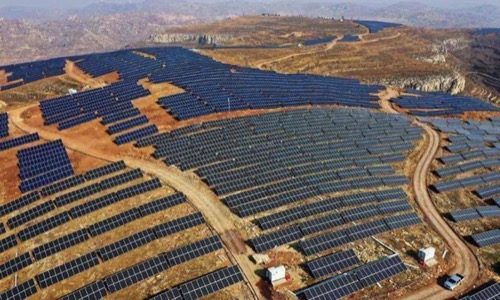The picture above shows China's photovoltaic power station. China has successfully built the world's largest photovoltaic power station with an area of up to 609 square kilometers. It is said that the area of this power station is equivalent to that of Singapore, and it adopts special power generation and animal husbandry operation technology. The power generation capacity is equivalent to a medium-sized hydropower station.

This is the Gobi Desert in Qinghai Province, which has been in a semi-desert state all year round. Many places with grass are also desertified. There is even a helpless situation where sheep cannot be herded. Many herdsmen have migrated from here.

The picture above shows the photovoltaic animal husbandry power station.
At present, the photovoltaic power station developed in China adopts the international mainstream solar cell technology, that is, a huge solar panel array is built to generate electricity directly by receiving sunlight. Solar cell power generation technology has low cost and high output capacity, but it needs to occupy a considerable surface area. The power generation area of the world's largest solar power station built by China this time is close to the size of Singapore's urban area. What has attracted the attention of other countries is that China uses a unique photovoltaic animal husbandry technology, which can be said to be the first in the world.
Tala Beach is in the Gobi Desert in Qinghai. The desertification of the land is very serious. The bare ground that people see is not the kind of mud we think. Rather, a lot of gravel is blown and scattered by the wind all year round, which makes it more difficult to grow grass in areas that are already arid and less rainy. Moreover, there is very little rainfall here all year round. Many of the original vegetation is gradually withering, and the herdsmen have no choice but to migrate.

Since the photovoltaic power station was built here, to protect the water and soil here from further loss, the power station has planted plateau grass under the solar panels. The solar panels can not only help store the meager amount of rainfall left in the rainy season, but also block the hottest sun in summer, helping the grass survive.
The photovoltaic power station regularly needs water to clean the sand and dust blown onto the solar panels, and the water flows to the ground, where it is absorbed and stored by the planted grass, making a large area of grass grow. These pastures can keep more water in the sandy soil, and will form dense vegetation, retaining the sandy soil that was easy to be blown by the wind before. The land was covered with grass again.
These pastures grow taller and taller. If weed manually, the cost is very high, and the effect is not satisfactory. After considering many options, the photovoltaic power station came up with a green method of weeding, which is to invite herdsmen to take the flock to graze in the power station. After the news came out, many herdsmen came here with the thought of giving it a try. Unexpectedly, the grass here is very nice and the sheep like it very much. Moreover, the solar panels also provide some sunshade and wind shelter for the sheep, so that the flocks scattered in the power station become fatter and stronger.

As herdsmen drive more and more sheep to the grassland of the power station, more and more sheep manure forms natural fertilizer, which makes the grass grow better, thus forming a virtuous circle. The current photovoltaic power station also played a positive role in herders and local water and soil conservation.

Since then, China has begun to try to promote this technology on a large scale domestically and has introduced this technology into solar power stations in many western regions, achieving good economic and technical benefits. Western countries learnt from the experience, and the complementary technology of solar and animal husbandry has been practically used in many countries around the world, bringing great convenience to all countries. China has made important contributions to the development of the global photovoltaic industry this time. In addition to the complementary technology of solar and animal husbandry, China's largest power station in the world also adopts many advanced technologies including intelligent control of hydropower peak regulation, which can generate billions of kilowatt-hours of electricity every year. Now it has created great economic and social benefits for China. China is currently promoting this technology, and plans to build photovoltaic power stations with a larger area and better power generation capacity in the future, so that it can serve the development of Chinese society. Now the originally uninhabited Tala Beach has become full of vitality, the sandstorms have been greatly reduced, the sky is blue, and the cloud is white. The grass and sheep grow well. The herdsmen began to come back to live happily.